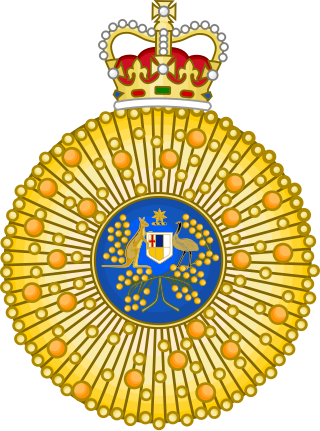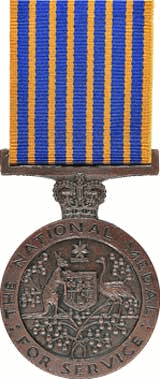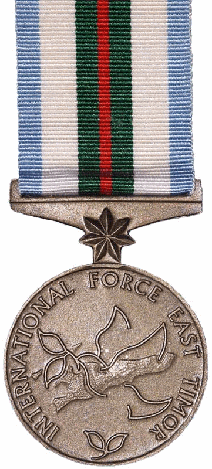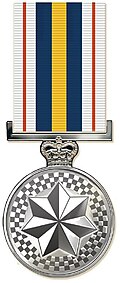
The Order of Australia is an Australian honour that recognises Australian citizens and other persons for outstanding achievement and service. It was established on 14 February 1975 by Elizabeth II, Queen of Australia, on the advice of then prime minister Gough Whitlam. Before the establishment of the order, Australians could receive British honours, which continued to be issued in parallel until 1992.
The Australian honours and awards system refers to all orders, decorations, and medals, as instituted by letters patent from the Monarch of Australia and countersigned by the Australian prime minister at the time, that have been progressively introduced since 14 February 1975. The Australian honours and awards system excludes all state and local government, and private, issued awards and medals.

The British Empire Medal is a British and Commonwealth award for meritorious civil or military service worthy of recognition by the Crown. The current honour was created in 1922 to replace the original medal, which had been established in 1917 as part of the Order of the British Empire.

The King's Police Medal (KPM) is awarded to police in the United Kingdom for gallantry or distinguished service. It was also formerly awarded within the wider British Empire, including Commonwealth countries, most of which now have their own honours systems. The medal was established on 7 July 1909, initially inspired by the need to recognise the gallantry of the police officers involved in the Tottenham Outrage. Renamed the King's Police and Fire Services Medal (KPFSM) in 1940, it was replaced on 19 May 1954 by the Queen's Police Medal (QPM), when a separate Queen's Fire Service Medal was also instituted. The current award was renamed the King's Police Medal following the death of Queen Elizabeth II in 2022 and the accession of King Charles III to the throne of the United Kingdom.
The orders, decorations, and medals of Canada comprise a complex system by which Canadians are honoured by the country's sovereign for actions or deeds that benefit their community or the country at large. Modelled on its British predecessor, the structure originated in the 1930s, but began to come to full fruition at the time of Canada's centennial in 1967, with the establishment of the Order of Canada, and has since grown in both size and scope to include dynastic and national orders, state, civil, and military decorations; and various campaign medals. The monarch in right of each Canadian province also issues distinct orders and medals to honour residents for work performed in just their province. The provincial honours, as with some of their national counterparts, grant the use of post-nominal letters and or supporters and other devices to be used on personal coats of arms.

The Australian Active Service Medal (AASM) is an Australian military decoration. It was authorised on 13 September 1988 to recognise prescribed service in "warlike" operations, backdated to February 1975. It is awarded with a clasp to denote the prescribed operation and subsequent awards of the medal are made in the form of additional clasps. In 2012, it was announced that the medal would no longer be issued for future operations, with the AASM and the Australian Service Medal being replaced by the Australian Operational Service Medal.

The Star of Gallantry (SG) is a military decoration awarded to personnel of the Australian Defence Force (ADF) and other persons recognised by the Minister for Defence. It is awarded for acts of great heroism or conspicuous gallantry in action in circumstances of great peril. It is the second highest of the military gallantry awards in the Australian Honours System, only surpassed by the Victoria Cross or Victoria Cross for Australia (VC).

The Reserve Force Decoration is an Australian Military award given for long service by officers of the Reserve Forces. It is part of the suite of defence force service awards introduced in 1982, which also included the Defence Force Service Medal and the Reserve Force Medal. However, the RFD is the only one of the three to carry a postnominal entitlement.
The Nursing Service Cross (NSC) is a conspicuous service decoration of the Australian honours and awards system, instituted by Letters Patent on 18 October 1989.

The National Medal is an Australian award given for long service by operational members of specified eligible organisations. It was introduced in 1975, as an original component of the new Australian honours system, and replaced a range of medals available to military and civilian uniformed services for long service and good conduct. The eligible groups have in common that their members serve or protect the community at the risk of death, injury or trauma, hence it is only available to members of the eligible organisations who are operationally deployed. In the case of corrective services, eligibility is restricted to officers with custodial duties.
The Australian Police Medal (APM) is awarded for distinguished service by a member of an Australian police force. The APM was introduced in 1986, and replaced the Imperial King’s Police Medal for Gallantry and King’s Police Medal for Distinguished Service.

The Australian Cadet Forces Service Medal is awarded to recognise long and efficient service by officers and instructors in the Australian Defence Force Cadets. It is awarded for 15 years service. Additional clasps are issued for every 5 years additional service.

The Australia Service Medal 1939–1945 recognises service in Australia's armed forces, Mercantile Marine and Volunteer Defence Corps during World War II.

The International Force East Timor (INTERFET) Medal recognises members of the Australian Defence Force who served for 30 days in East Timor during the INTERFET campaign. The qualifying area comprises East Timor and the sea adjacent to East Timor out to a distance of 12 nautical miles (22 km) from the low water mark.

The Australian General Service Medal for Korea (AGSMK) recognises former defence force personnel who completed 30 days of service in operations in South Korea, including any location 161 km (100 mi) seaward from the coast of South Korea, during the post-Armistice period, 28 July 1953 to 19 April 1956. The medal was established by letters patent by Queen Elizabeth II on 24 November 2009 and further determination approved by the Governor General on 12 March 2010. The AGSMK was announced on 12 February 2010 by the Parliamentary Secretary for Defence Support, the Hon Dr Mike Kelly AM MP, following the recommendations of the 2005 Post-Armistice Korean Service Review.

The Operational Service Medal is a campaign medal created in 2010 by the Canadian monarch-in-Council to recognize members of the Canadian Forces, allied forces, Canadian police officers, or Canadian civilians working for the Canadian Forces who had directly participated in any military campaign under Canadian or allied command. It is, within the Canadian system of honours, the lowest of the war and operational service medals.
The State of Queensland has created several independent honours to that of the Australian Honours System.
The Police Diligent and Ethical Service Medal, also known as the New South Wales Police Medal, is a decoration for police officers of the New South Wales Police Force. First instituted in 2002, the 36 mm medals are copper, with a nickel coating. The medal is awarded to sworn members and former sworn members of the New South Wales Police Force who have completed ten years of diligent and ethical service. The clasp to the medal is awarded for each additional 5 years of diligent and ethical service.

The Western Australia Police Medal was established to recognise Western Australia Police personnel who have completed sustained diligent and ethical service to the Western Australia Police.
The Australian Intelligence Medal (AIM) is a civil decoration awarded to national intelligence community members for distinguished service. The decoration was introduced on 24 January 2020. Recipients of the Australian Intelligence Medal are entitled to use the post-nominal letters "AIM".













